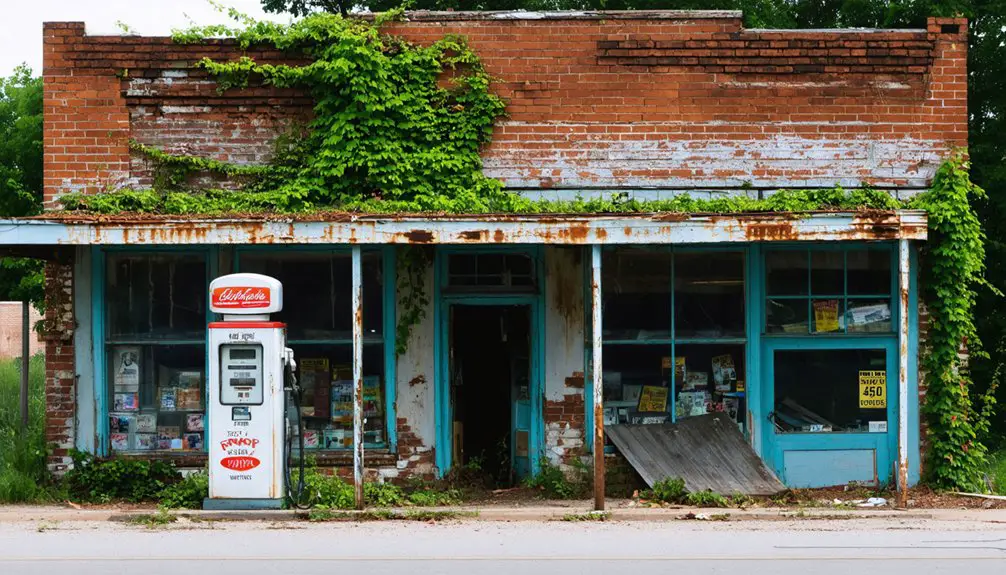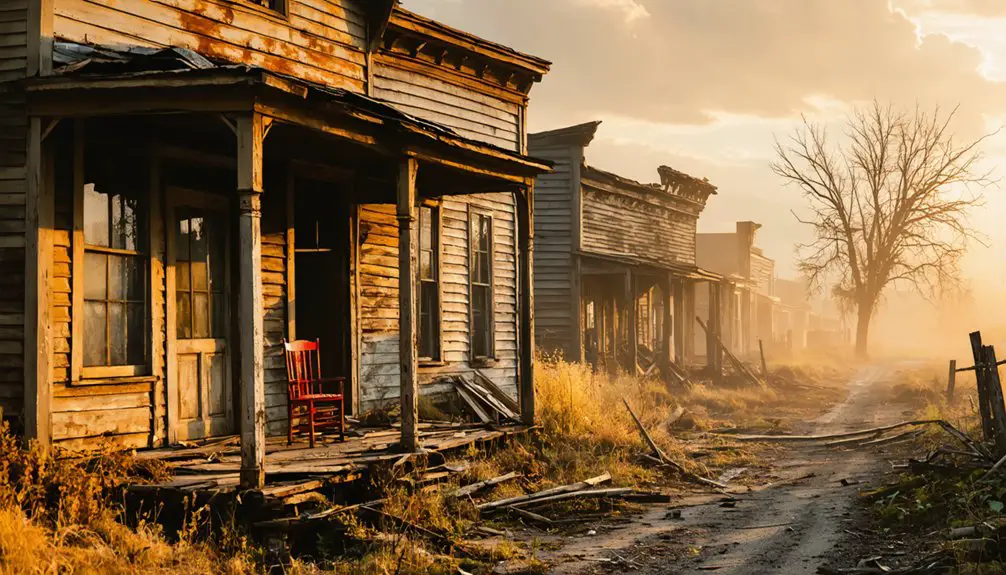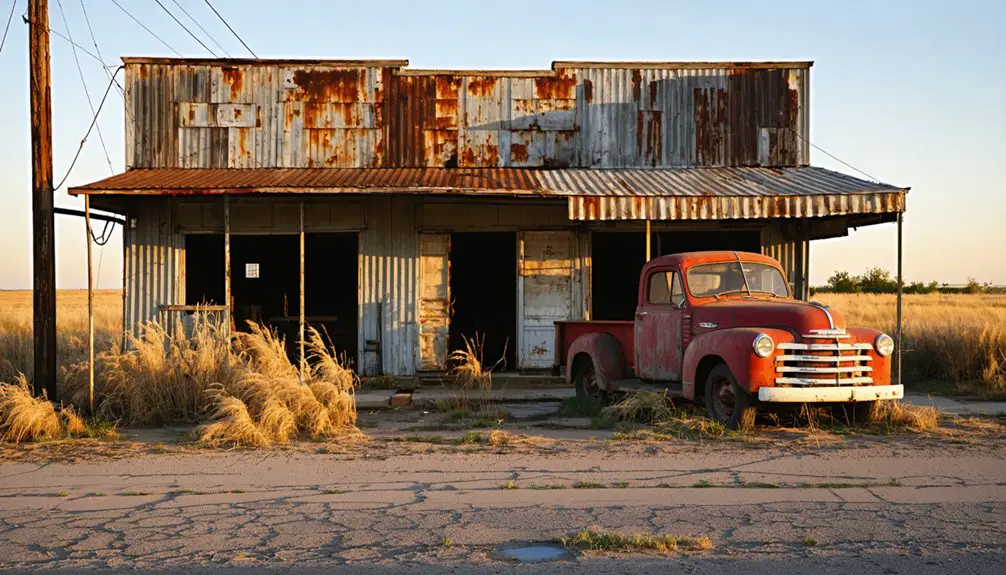You’ll find Braithwaite’s story began in 1907 when the Kansas City, Mexico and Orient Railway established a strategic depot in western Oklahoma Territory. Named after railway stockholder J.S. Braithwaite, this African American farming community thrived around its railroad connections, general store, and church. The town’s prosperity relied heavily on rail transport and agriculture, but like many Oklahoma settlements, economic shifts and resource depletion led to its eventual abandonment – though its legacy holds deeper stories of resilience and change.
Key Takeaways
- Braithwaite was established in 1907 as a railroad town along the Kansas City, Mexico and Orient Railway in western Oklahoma.
- The town thrived initially as an African American farming community with essential buildings including stores, homes, and a church.
- The railroad depot served as the economic center, enabling trade and transportation of coal and agricultural products.
- Economic decline followed resource depletion and railroad financial troubles, leading to business closures and population loss.
- Today, Braithwaite stands as one of Oklahoma’s 2,000 ghost towns, with its legacy preserved through oral histories and family memories.
The Birth of a Railroad Town
When the Kansas City, Mexico and Orient Railway expanded through western Oklahoma in 1907, it gave birth to Braithwaite, one of many railroad towns that emerged during Oklahoma’s railway boom.
You’ll find the town’s railroad significance embedded in its very name, chosen to honor J.S. Braithwaite, a railway stockholder who invested in the promise of this frontier settlement.
The railroad’s strategic town planning positioned Braithwaite as an essential commercial hub, complete with a depot that would serve both passengers and freight operations.
The bustling depot stood as Braithwaite’s beating heart, orchestrating the flow of people and goods through this strategic prairie crossroads.
Around this iron lifeline, merchants established stores, workers built homes, and farmers gained a gateway to distant markets. Similar to nearby towns like Breckenridge and Hunter, Braithwaite’s early growth was driven by the intersection of vital rail lines.
Like many settlements of its era, Braithwaite’s existence centered entirely on the railroad’s ability to connect isolated prairie communities to the wider world of commerce and opportunity. This contrasts sharply with the modern English village of Braithwaite, where the Cockermouth Railway station has long since closed.
Early Settlement and Development
You’ll discover that Braithwaite’s first wave of settlers arrived alongside the railroad’s construction in the late 19th century, bringing with them the determination to establish a permanent community in Oklahoma Territory.
Within months, these pioneers had constructed essential wooden buildings, including a general store, blacksmith shop, and modest homes along the newly laid tracks. Like the Cherokee Outlet run of 1893, the settlement represented a significant moment in Oklahoma’s territorial expansion.
The railroad’s presence attracted more settlers throughout 1890-1891, who quickly established a schoolhouse and church, creating the foundation for what they hoped would become a thriving agricultural hub. Many African Americans were drawn to the area after E.P. McCabe actively recruited settlers from the Deep South.
Railroad Brings New Life
The arrival of the Oklahoma Central Railroad in 1906 transformed Braithwaite from a remote settlement into a bustling hub of economic activity.
You’d have witnessed the railroad benefits firsthand as coal transport capabilities opened new markets and trading opportunities. The rail line’s Class I standards guaranteed reliable operations, connecting you to larger commercial networks that were previously out of reach.
Community growth flourished as the railroad depot became a centerpiece for business development. You could now access essential goods, medical services, and diverse economic opportunities beyond agriculture. The railway’s primary mission of transporting coal from Lehigh helped fuel the region’s industrial expansion. Federal officials had secured rights-of-way from tribes through reconstruction treaties, enabling the railroad’s development through Indian Territory.
While some Native Americans in the territory viewed the railways with skepticism, others recognized their potential for prosperity. The Dutch and British-financed rail expansion positioned Braithwaite as a crucial link in Oklahoma’s growing transportation network, forever changing the town’s destiny.
Settlers Establish First Buildings
Brave settlers staked their claims in Braithwaite following the Cherokee Outlet land run of 1893, transforming open prairie into a fledgling community.
You’d have found these pioneers living in basic settler shelters – dugouts carved into hillsides, sod houses built from prairie earth, or log cabins when timber was available. Like many communities that would become oil boom towns, these early settlers chose their locations carefully, staying close to creeks and following old Native American trails.
As more families arrived, they joined forces to construct essential community buildings. Like many of Oklahoma’s estimated two thousand ghost towns, Braithwaite began with high hopes and determination.
You’d have seen their first church and one-room schoolhouse rise from the earth, built by determined hands using local materials. A general store and blacksmith shop soon followed, creating a town center where dirt paths would eventually become streets.
Every building reflected their resourcefulness and will to survive harsh Oklahoma conditions.
The Kansas City, Mexico and Orient Railway Connection
You’ll find the Kansas City, Mexico and Orient Railway’s reach into Braithwaite marked a turning point in the town’s development when tracks were laid through Oklahoma in the early 1900s.
Track construction proceeded steadily from Wichita through Oklahoma Territory, reaching key development points by 1903.
As the KCM&O established its primary shops in nearby Fairview, the railway’s presence brought increased commerce and connectivity to Braithwaite during the line’s expansion through Clinton and Altus. The railway’s ambitious plans mirrored the growth seen in Kansas City’s economy, which was rapidly expanding as a major transportation hub.
The railway’s eventual financial troubles, including its 1912 receivership and subsequent reorganizations, mirrored Braithwaite’s own economic challenges as the promising transportation link failed to deliver its full potential.
Railway Investment Impact
During the early 1900s, Kansas City, Mexico and Orient Railway (KCM&O) transformed Braithwaite’s economic landscape by establishing essential transportation links that connected the small Oklahoma town to major markets.
Railway investment initially boosted local employment through track construction and repair facilities in nearby Fairview, while creating critical access points for agricultural and oil products.
However, you’ll find that Braithwaite’s economic sustainability faced significant challenges. The 1910 fire that destroyed Fairview’s repair shops, followed by KCM&O’s 1912 bankruptcy, dealt severe blows to the region.
While oil discoveries helped maintain some railway operations, the 1928 acquisition by Santa Fe Railway diminished Braithwaite’s importance as a main line stop, ultimately contributing to its decline as investment patterns shifted toward larger urban centers.
Track Route Development
When the Kansas City, Mexico and Orient Railway began laying tracks in 1900, its ambitious vision stretched far beyond Braithwaite’s borders, aiming to create a 1,600-mile rail corridor from Kansas City to Mexico’s Pacific port of Topolobampo.
The railway expansion quickly reached Oklahoma Territory, with tracks extending from Wichita to Fairview by 1903. You’d have seen the line continue through Clinton and Altus before pushing into Texas.
By 1909, the rails stretched to San Angelo, and by 1913, they’d reached Alpine, where they connected with the Southern Pacific Railroad.
The economic significance of this route was immense, as it promised to link America’s heartland directly to Pacific trade. Though financial troubles and the Mexican Revolution hindered the railway’s complete vision, it transformed the region’s transportation landscape.
Daily Life in Early Braithwaite
Life in early Braithwaite revolved around a tight-knit African American community where families supported each other through farming, local trade, and shared social gatherings.
You’d find residents working their fields from sunrise to sunset, following the natural rhythms of planting and harvest seasons. Local occupations included blacksmithing and small-scale trading, while some residents operated general stores or provided essential services.
Community gatherings centered around the local school and church, where you’d experience vibrant social connections through religious services, meetings, and celebrations.
Daily routines involved trips to the post office, children attending the local school, and occasional journeys to nearby towns for supplies you couldn’t find locally.
Despite limited transportation options and economic challenges, residents built a resilient, self-sufficient community free from the discrimination faced elsewhere.
Economic Rise and Fall

The self-sufficient community of Braithwaite transformed dramatically with the discovery of valuable natural resources in the region.
You’d have witnessed a rapid influx of workers and investors, drawn by promises of quick wealth in the extractive industry. The town’s economic fluctuations mirrored the volatile nature of resource-based economies, with prosperity tied directly to commodity prices and market demands.
Boom towns rise and fall on the promise of riches, their fate forever tied to the resources they extract.
Labor dynamics shaped Braithwaite’s development as workers rushed in during boom times, driving up housing costs and spurring rapid infrastructure growth.
The railroad’s arrival further accelerated this expansion, connecting the town to crucial markets.
However, when the primary resource began to deplete, you’d have seen the town’s fortune reverse swiftly.
Businesses closed, workers departed, and the once-bustling community faced inevitable decline as its single-industry economy collapsed.
The Path to Abandonment
Despite Braithwaite’s promising start as a railroad settlement in 1907, its path toward abandonment began taking shape through a complex web of interconnected factors.
You’d have witnessed the town’s decline accelerate as the Kansas City, Mexico and Orient Railway’s importance diminished, cutting off crucial economic lifelines. The lack of highway access isolated Braithwaite further as automobile travel gained dominance, while resource depletion stripped away the town’s economic foundations.
Transportation shifts meant you couldn’t easily reach larger markets, and demographic changes saw your neighbors departing for urban opportunities. As essential services relocated to bigger towns nearby, you’d have watched Braithwaite’s population dwindle dramatically.
Legacy and Historical Impact

Although Braithwaite’s physical structures have long since vanished, its legacy endures as a meaningful chapter in Oklahoma’s historical narrative.
You’ll find its cultural significance woven into the fabric of Washita County’s heritage, preserved through oral histories and family memories passed down through generations.
The town’s story mirrors the broader experience of nearly 2,000 Oklahoma ghost towns, offering valuable insights into the region’s economic evolution and settlement patterns.
Community connections remain strong among descendants of former residents, who maintain their ancestral ties to this once-thriving settlement.
Today, Braithwaite serves as both a symbol of the resilient spirit of early Oklahoma settlers and a reminder of how shifting economic forces can reshape rural landscapes.
Braithwaite stands as a testament to pioneer determination, while showing how economic change can transform Oklahoma’s rural communities.
Historians and genealogists continue to study its impact on regional development.
What Remains Today
Standing as a solitary sentinel to Braithwaite’s past, an aging rail depot marks the only remaining structure at this forgotten Oklahoma settlement.
A remnants analysis reveals that time has erased nearly all traces of the former community, with no visible foundations, homes, or businesses left to explore. You’ll find the surrounding landscape has returned to its natural state, with agricultural fields and wild vegetation reclaiming what was once a bustling town.
The site exhibits classic ghost town characteristics of the barren category – there are no paved roads, sidewalks, or utility infrastructure remaining.
If you venture to this remote Washita County location today, you won’t find any historical markers or preserved artifacts, just open country surrounding that weathered depot, the last witness to Braithwaite’s existence.
Frequently Asked Questions
Were There Any Notable Crimes or Lawlessness in Braithwaite’s History?
You won’t find records of notable crime rates or specific law enforcement issues in this area, unlike nearby oil boom towns that experienced significant lawlessness in early 1900s Oklahoma.
What Native American Tribes Originally Inhabited the Land Where Braithwaite Was Built?
You’d recognize the rich tribal history of the Wichita peoples, who left a profound cultural impact on this land, alongside the Apache, Comanche, and Kiowa before forced relocation changed everything.
Did Any Famous People Ever Visit or Live in Braithwaite?
You won’t find records of famous visitors in Braithwaite’s history. The town’s historical significance was tied primarily to its railway connection, without documented evidence of any notable residents or celebrity visits.
What Natural Disasters or Severe Weather Events Affected Braithwaite?
You’ll find that flooding events commonly affected the area, with severe storms and possible tornadoes impacting the town. While specific disasters aren’t documented, regional weather patterns suggest regular environmental challenges for residents.
Were There Any Schools or Churches Established in Braithwaite?
You won’t find documented evidence of schools or churches in Braithwaite’s education history or religious influence. Though nearby towns had such institutions, no records confirm their existence here.
References
- https://en.wikipedia.org/wiki/List_of_ghost_towns_in_Oklahoma
- https://www.okhistory.org/publications/enc/entry?entry=GH002
- https://okmag.com/blog/a-ghostly-site/
- https://kids.kiddle.co/List_of_ghost_towns_in_Oklahoma
- https://www.wikiwand.com/en/articles/Braithwaite
- https://www.youtube.com/watch?v=VJXBWheKanY&vl=en-US
- https://www.okhistory.org/publications/enc/entry?entry=RA004
- https://okgenweb.net/~okwashit/towns.htm
- https://www.youtube.com/watch?v=-jYN1_E2VV0
- https://www.kosu.org/local-news/2014-05-23/ghost-towns-all-black-oklahoma-towns



